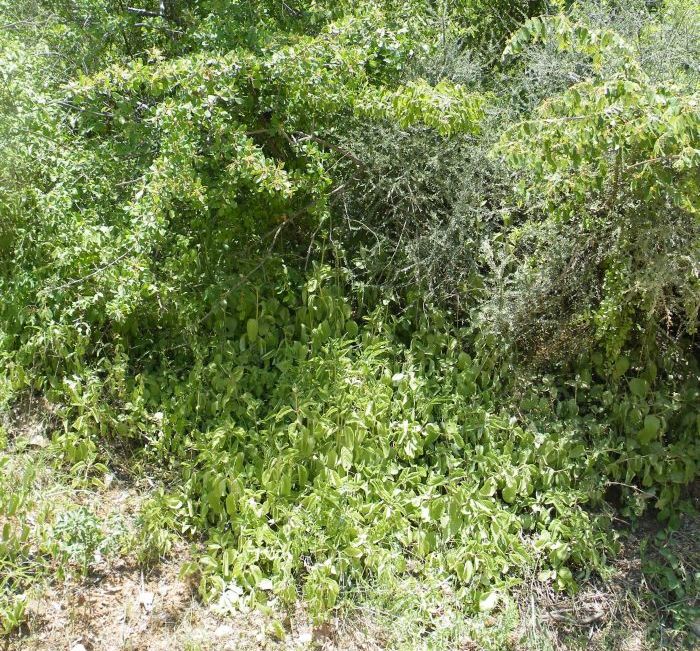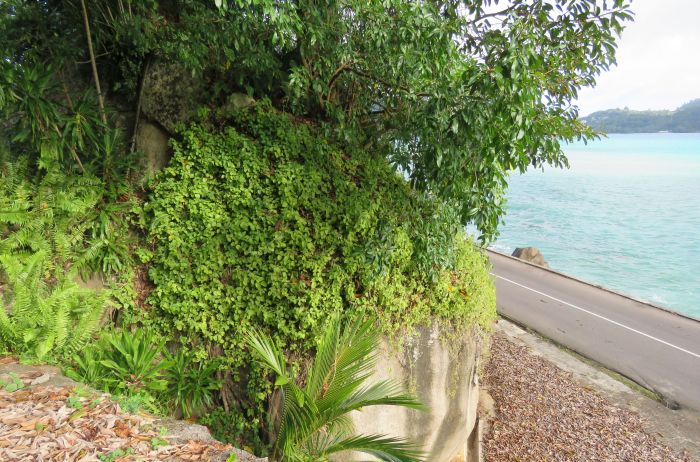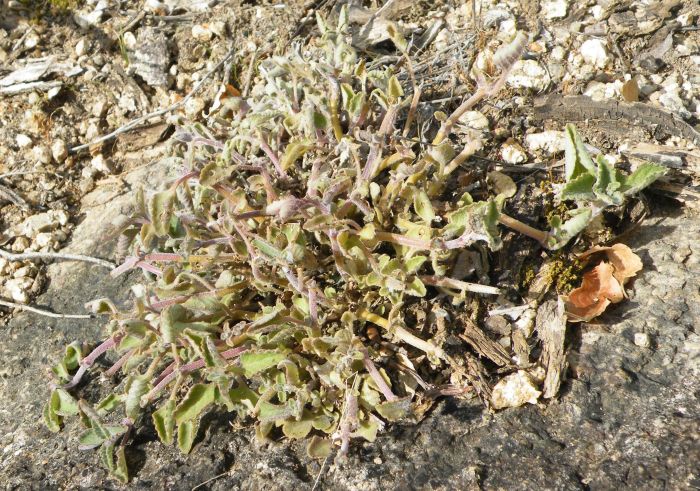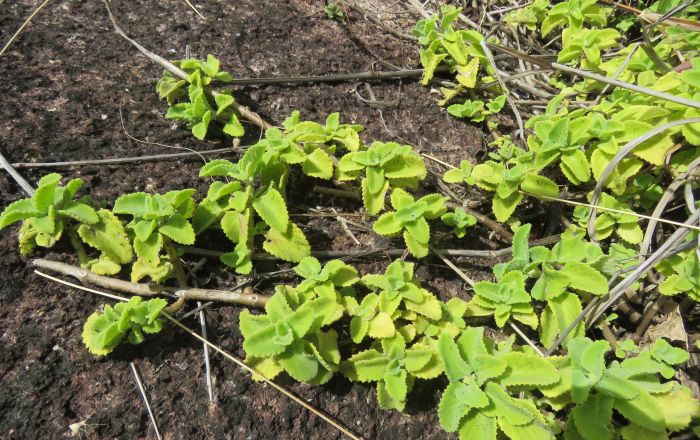Coleus amboinicus
Coleus amboinicus Lour. (= Plectranthus amboinicus (Lour.) Spreng.)
Family: Lamiaceae
Common names: African thyme, French thyme, country borage, Indian borage, Indian mint, broad-leaf thyme, soup mint (Eng.); Afrika-tiemie, krui-spoorsalie (Afr.)
Introduction
A sprawling perennial with strongly and pleasantly aromatic, fleshy, serrated leaves and mauve, two-lipped flowers in summer and autumn. A useful, easily grown and propagated, water-wise plant for rockeries, containers and also an aromatic herb for spicing up food. It grows wild in dry river valleys in northern KwaZulu-Natal in South Africa and is also common in southern, central and eastern Africa.

Figure 1. Coleus amboinicus flowering in a garden in Stellenbosch, Western Cape.
Description
Description
Coleus amboinicus is a rapid growing, branched, evergreen, ascending, spreading shrublet, 300–700 mm tall. The roots are fibrous. All parts are highly and pleasantly aromatic. The stems are ascending spreading (decumbent) and up to 1.5 m long, succulent, almost rounded to somewhat 4-angled, green when young and about 4 mm in diameter, the mature stems becoming brownish and about 7 mm in diameter. The stem surface is covered in dense, whitish, translucent, long and short, multicellular hairs. The internodes are 5–55 mm apart, depending on the growing conditions. Leaves are brittle, broadly egg-shaped to triangularly egg-shaped (ovate) with a short petiole 8–20 mm long; the blade is 35–50 mm long and 25–47 mm in diameter. When grown under exposed, sunny, dry conditions, the leaves are shorter and folded in (conduplicate), however, in shady, moist conditions the leaves tend to be flattened and only slightly concave. The margin with about 12 pairs of shallow pointed teeth. The base of the leaf is truncate and the tip (apex) acute to almost rounded. The surface is covered in tiny, translucent to brownish gland dots and is very hairy, especially on the conspicuous network of veins on the lower surface.

Figure 2. Coleus amboinicus flowers.
The inflorescence is a terminal raceme, 100 to 500 mm long; the flowers are arranged in whorls of 4–10, each flower 7–9 mm long, white to mauve and slightly deflexed, expanding to the throat. The calyx is 2–3 mm long, elongating to 5–6 mm when mature. The seed is a light to dark brown, slightly flattened nutlet, 1 mm across.
Flowering time is late summer to autumn, the seeds released in winter and spring. In cultivation, and especially the tropics, it can flower at other times of the year.
Conservation Status
Status
Fairly common and widespread, consequently it is assessed as Least Concern (LC) by the Red List of South African plants.

Figure 3. Coleus amboinicus growing among granite rocks below Terminalia prunoides (Bibala, southwestern Angola).
Distribution and habitat
Distribution description
Coleus amboinicus has a wide distribution but is confined to the dry river valleys of northern KwaZulu-Natal in South Africa and in Eswatini, Mozambique and further north to Kenya. It is also commonly encountered on Indian Ocean Islands such as Inhaca Island, Seychelles and Mauritius. The vegetation in KwaZulu-Natal, where the plant was encountered, consists of Southern Lebombo Bushveld which is part of the Savanna Biome. (Mucina & Rutherford 2006). These river valleys have a fairly dry climate that is intensified by the steep slopes, and consequently during periods of rain, have a high run off. This habitat is rocky and rich in species of succulent plants. Coleus amboinicus grows on steep rocky embankments and cliffs. It is mostly found in full sun and partial shade. The climate here is subtropical, hot in summer but cooler in winter, however, frost is absent. Rainfall is experienced mainly in the summer months and often associated with thunder showers. Rainfall ranges from 500 to about 1 000 mm per annum. The geology in its KwaZulu-Natal habitat consists mainly of igneous rhyolite rocks of the Jozini Formation, Lebombo Group (Karoo) (Keyser 1997). In southern Angola plants were found in semi-arid savanna on granite hills in partial shade of bushveld trees, such as Colophospermum mopane (mopane), Terminalia prunoides and Moringa ovalifolia.
Along the Mkuze River in the Mkuze Game Reserve, plants were found growing on a steep slope above a cliff and together with Aloe spicata, Coleus cylindraceus, Commiphora schimperi, Euphorbia tirucalli, Kalanchoe sexangularis, Kleinia fulgens, Portulacaria afra and Sarcostemma viminalis.
In the Seychelles, plants were found growing locally abundant in coastal scrub and in dense groups on granite, sea-facing, rocky terrain and cliffs.

Figure 4. Coleus amboinicus growing on a coastal cliff in the Seychelles (Indian Ocean Island).
Derivation of name and historical aspects
History
Coleus amboinicus belongs to the mint family (Lamiaceae), a large family of about 7 000 species and 240 genera, with aromatic opposite leaves, square stems and 2-lipped flowers (Christenhusz et al 2017). C. amboinicus was first named by the botanist Loureiro in his Flora cochinchinensis in 1790. It was named from the spice island of Amboina in the Far East. The plant grows commonly on Indian Ocean Islands and because of its medicinal and herbal use, it was soon spread by early voyagers to India and the Far East (Codd 1985).
The genus name Coleus was established by Loureiro in the same journal as above (1790) with Coleus amboinicus as the type. The generic name Coleus is of Greek origin, koleos, meaning ‘sheath’, pertains to the floral filaments which are fused at the base, sheathing the style (Clarke & Charters 2016). The most commonly grown Coleus is C. scutellarioides, a species known as the flame nettle or Joseph’s cloak, with often, strikingly beautiful leaf colours, from tropical and subtropical Asia and northern Australia.
In 1962, Morton merged Coleus into Plectranthus but in 2019, Paton and his co-workers re-established the genus Coleus based on molecular evidence, recognizing the 294 species of Coleus previously placed within Plectranthus. The genus Plectranthus has been reduced to 72 species of mainly African and Madagascan origin. According to Paton and his 8 co-authors, the diagnostic features separating Coleus from its close relatives Equilabium and Plectranthus, are the asymmetrical pedicel attachment at the base of the calyx. The floral bracts are usually imbricate and soon deciduous, but not imbricate and persistent in Plectranthus. The corolla tube in Plectranthus is usually straight, but bent in Coleus and Equilabium. Also the upper lip of the corolla is usually much shorter than the lower lip in Coleus. The slightly flattened nutlet of Coleus is also diagnostic.
There are 27 species of Coleus occurring naturally in southern Africa, of which most are semi-succulent or succulent and all were previously placed in the genus Plectranthus. Coleus species in South Africa and Namibia include: Coleus aliciae, C. amboinicus, C. barbatus, C. calycinus, C. cylindraceus, C. dinteri, C. dolichopodus, C. esculentus, C. gibbosus (= Plectranthus. rehmannii), C. grandidentatus, C. hadiensis, C. hereroensis, C. lasianthus (= Plectranthus tetensis), C. madagascariensis, C. mutabilis, C. neochilus, C. pentheri, C. porcatus, C. psammophilus, C. rotundifolius, C. tetragonus, C. rehmannii, C. psamophilus, C. unguentarius, C. venteri, C. welwitschii and C. xerophilus.

Figure 5. A stressed specimen of Coleus amboinicus growing on a granite dome together with Aloe scorpoides (near Bibala, southwestern Angola).
Ecology
Ecology
The succulent nature of the plant enables it to survive periods of drought which are so often experienced in dry habitats, such as rocky, river valleys and coastal rocks. When the plant is trampled or disturbed, living stems which fall to the ground will root, and this is so typical of many of the succulent and semi-succulent plants from dry river valleys. Passive resistance and chemical defence is the secret of their long term survival, a strategy enabling the plant to take advantage to animal disturbances so often associated with succulents of the savanna vegetation of this region. Instead of succumbing when trampled or grazed, parts of the stems are able to root, ensuring its survival and also acts as a vegetative cloning back-up. The plants are strongly and pleasantly aromatic, a chemical defence against insects and other animals utilizing the leaves. The mauve to whitish flowers are pollinated by solitary and other bees. Seed is released when the calices become detached, with local dispersal. Wind may play a role in dispersal.
Coleus amboinicus is also resistant to salt-laden winds along the coast.

Figure 6. Coleus amboinicus, close-up of the leaves and stems, growing on granite bedrock along the Seychelles coast (Indian Ocean Islands).
Uses
Use
Apart from its horticultural uses, the fresh leaves of Coleus amboinicus are widely utilized both as a medicinal plant and as a herb or spice providing flavour to food (meat and poultry dishes), especially in tropical and subtropical parts of the world, where it is grown in kitchen gardens and containers and it is used the same way as thyme, hence some of the common names (Van Wyk 2005). I regularly use the fresh leaves for flavouring salads.

Figure 7. Coleus amboinicus growing on granite bedrock near the coast in the Seychelles (Indian Ocean Island).
Growing Coleus amboinicus
Grow
Coleus amboinicus is very easily grown and cultivated and today popular throughout the world where the climate permits. It is best suited for Mediterranean, bushveld and subtropical gardens (Van Jaarsveld 2010). It is frost tender but will tolerate light frost. It is best grown in full sun as an informal scrambling ground cover. It will tolerate half shade. Plant cuttings in situ about 50 cm apart preferably in spring or summer, and when well-watered, will rapidly root and grow. Once established, the plant should be self-sustaining and thus the ideal water-wise garden plant. It should also flower within the first season of planting. Prune back two thirds during the winter months to ensure a neat growth. The plant responds well to fertilizer. There are several strains and also a variegated cultivar.
Cuttings of about 10 cm length should be used. Remove lower leaves and plant in sand or peat or a sterile growth medium in a tray or suitable container. Keep moist, place in a sunny to light shady corner. Rooting is rapid during the warmer part of the year. Once rooted, the plants can be transferred to containers or directly to the garden.
References
- Christenhusz, M.J.M., Fay, M.F. & Chase, M.W. 2017. Plants of the World, an illustrated Encyclopedia of vascular plants. Kew Publishing, Royal Botanic Gardens, Kew.
- Clarke, H. & Charters, M. 2016. The illustrated dictionary of southern African plant names. Flora & Fauna Publications Trust, Jacana, Johannesburg.
- Codd, L.E. 1985. Lamiaceae. Flora of southern Africa, Vol. 28, 4. Botanical Research Institute, Department of Agriculture and Water Supply, Pretoria.
- Keyser, N. 1997. Geological Map of the Republic of South Africa and the Kingdoms of Lesotho and Swaziland. Council for Geoscience, Pretoria.
- Koekemoer, M., Steyn, H.M. & Bester, S.P. 2015. Guide to Plant Families of southern Africa. Strelitzia 31. 2nd ed., 2nd print. South African National Biodiversity Institute, Pretoria, South Africa.
- Lourier, de J. 1790. Flora cochinchinensis. Ulyssipore, Lisbon.
- Mucina, L. & Rutherford, M.C. (eds) 2006. The vegetation of South Africa, Lesotho and Swaziland. Strelitzia 19. South African National Biodiversity Institute, Pretoria.
- Paton, A.J., Mwanyambo, M., Govaerts, R.H.A., Smitha, K., Suddee, S., Phillipson, P.B., Wilson, T.C., Forster, P. I. & Culham, A. 2019. Coleus and Plectranthus (Lamiaceae): a tale of more than two genera. Phytokeys 129: 1–158.
- Van Jaarsveld, E. 2000. Wonderful water-wise gardening. Tafelberg, Cape Town.
- Van Wyk, B-E. 2005. Food plants of the World. Briza Publications, Pretoria.
Credits
Ernst van Jaarsveld
Kirstenbosch National Botanical Garden (Retired 2015)
Babylonstoren Farm
Extraordinary senior lecturer and researcher,
Department of Biodiversity and Conservation, University of the Western Cape
May 2020
Plant Attributes:
Plant Type: Ground Cover, Perennial, Succulent
SA Distribution: KwaZulu-Natal
Soil type: Sandy, Loam
Flowering season: Late Summer, Autumn
PH: Acid, Neutral
Flower colour: White, Mauve/Lilac
Aspect: Shade, Morning Sun (Semi Shade), Afternoon Sun (Semi Shade)
Gardening skill: Easy
Special Features:
Horticultural zones









Rate this article
Article well written and informative
Rate this plant
Is this an interesting plant?
Login to add your Comment
Back to topNot registered yet? Click here to register.